When Steady State is Anything But: Aligning Sustainment Posture for a Dynamic Theater of Operations
Dan Bartlett, Gary D. Jones and Steven L. Foster
For 1TSC, without question our ability to "Set the Theater" is our most critical Line of Effort (LOE) in support of USARCENT and the CENTCOM AOR. With a shift in focus in the National Defense Strategy, our ability to remain aligned with theater changes and the future posture of our AOR is essential as we continue to accomplish set the theater required tasks to support operations and contingency plans.
-- MG Flem B. “Donnie” Walker, CG, 1st Theater Sustainment Command
The United States’ ability to project and sustain power around the world is one of the nation’s key strategic advantages over her competitors. Maintaining rapid mobility assets, forward presence, and global partnerships, the Department of Defense (DoD) deters would-be adversaries and continually assures allies and partners. Protecting this advantage is not an accident, but rather the product of careful, deliberate planning and extensive logistical analysis. As the Army organization responsible for operational sustainment for United States Army Central (USARCENT) in support of the United States Central Command (USCENTCOM) Area of Responsibility (AOR), the 1st Theater Sustainment Command (TSC) is responsible for supporting the advancement of US interests in the region by planning, advocating for, and resourcing current and future sustainment footprints. This process is one where logistics planners try to ensure that capability and capacity will be available at required bases and geographic locations for known and suspected requirements – in short, making sure that the demands of the customer base will be met today and in the future. This process is so fundamental a duty that “Set the Theater” is one of four enduring lines of effort that articulate the functions of TSC as a worldwide organization. When setting the theater, there are two major tasks: the first is constructing and manning logistics nodes, and the second is understanding the limitations and authorities set by various multinational agreements.
For 1TSC, without question our ability to "Set the Theater" is our most critical Line of Effort (LOE) in support of USARCENT and the CENTCOM AOR. With a shift in focus in the National Defense Strategy, our ability to remain aligned with theater changes and the future posture of our AOR is essential as we continue to accomplish set the theater required tasks to support operations and contingency plans.
How Will the Theater Connect to the Supporting Industrial Base?
Constructing and manning logistics nodes requires an understanding of the end-to-end process of deployment and distribution operations, and how the joint deployment and distribution enterprise supports plans and operations. Setting the theater starts with connecting to the industrial base by engaging the joint deployment and distribution enterprise: Army Materiel Command (AMC), Defense Logistics Agency (DLA), and United States Transportation Command (USTRANSCOM). Launching a major campaign potentially requires millions of gallons of fuel, tons of ammunition, tons of sustainment stocks, replacement vehicles, aircraft and equipment, and substantial foreign military sale items. Once requirements for both daily operations and contingency plans are identified, a full review of available transportation modes and nodes with a USTRANSCOM feasibility analysis will indicate if sufficient capacity is present to support the theater operations. The analysis will also indicate if the transportation nodes are in the right places, and if the nodes can meet the type of transportation modes most often and most likely to provide support during the different phases of contingency operations.
Plans for utilization of the nodes in theater should account for higher commercial use during daily operations and uncontested contingency operations. During these conditions, commercial air, truck, and surface vessels will likely be the majority of supporting mode assets as they have bigger volume, lower cost, and more availability. If an operation or the theater becomes seriously contested, some modes of commercial assets may no longer be available to a theater’s more forward positions which creates a requirement for military air, ground, and surface vessels. Both military and commercial assets must be considered, as depending primarily on long term, heavy military transportation puts an enormous strain on the mobility air, and surface transportation asset availability across the DoD. Returning to commercial assets as quickly as possible puts the least strain on the DoD, and creates the most availability for air, sea, and ground assets. DLA and DLA-Energy (fuel) also support maximizing the efficiency of the transportation network and setting theater support by procuring and distributing some classes of supply and fuel from local or regional vendors.
Do We Have Agreements Granting Us the Authority and Authorization We Require?
With the theater modes and nodes properly aligned to connect the industrial base, and the strategic pipelines right-sized to cover the vast quantities of both deploying elements and sustainment; we look next to other considerations necessary to understand how best to execute the theater support plan, particularly those related to agreements and permissions. There may be gaps in a theater’s distribution plan until custom clearances are spelled out in country agreements between the COCOM, the Department of State, and the Host Nation. Timelines for clearance are another factor and can vary by days to months. Having dependable customs clearance and border crossing privileges depend on the US or coalition agreement made with each host country, and or the bilateral agreements made between that host country and its neighbors. One particular function that the U.S. Government often fulfills to enable strategic sustainment is negotiating pairs of bilateral agreements with neighboring countries to allow cross-border traffic in lieu of the two countries working out customs processes between themselves. The Theater Sustainment Command, Theater Army, and Geographic Combatant Command all play vital roles in key leader engagements to build strong support relationships and campaign posture within the region.
What Happens When Changing Requirements Outpace Sustainment Posturing?
The requirements that drive posture decisions change rapidly. COCOMs deal with changes in security environments and US relationships with countries in their area of operation on an almost daily basis; however, as the availability of advanced technology, increased nuclear threats, and the return to old adversarial relationships with near peer militaries continues, the National Defense Strategy and theater campaign plans are having major focus shifts. As a result, the current theater support plan for an AOR may no longer be correctly aligned to meet significant theater changes. Changes could include transferring a US/ North Atlantic Treaty Organization led campaign role to a regional coalition-based lead, changing priorities within a theater, new allies, or emerging threats. Therefore, it is important to look for key leader engagements to support the changes in the new Phase 0, and go back to the big three AMC, DLA, and USTRANSCOM for analysis and support.
Unfortunately, sustainment footprint development is an unwieldy and time-consuming process that is at best imprecise and is often inefficient. As much of it is executed through military construction (MILCON) projects, it is tied to planning, programming, budgeting, and execution and the program objective memorandum development processes. As a result, it takes multiple years to make any substantial changes to sustainment footprint or posture. This becomes a problem when one recognizes that the timeline is much longer than the timelines required for planning cycles for the operational contingency plans that the sustainment posture is designed to support. To restate, the customer base is much more agile than the operational sustainment framework that supports it, and, upon completion, MILCON projects which were bona-fide requirements when they were initiated may be either no longer needed, or inadequately small and unable to meet actual requirements.
How Do We Mitigate the Mismatch Between Posturing and Planning?
There are several different options that are potential ways through this problem, however each has its own risk. The most likely alternatives are: first, pacing the operational planning cycle to match the speed of the MILCON process; second, getting out of the theater-setting game for any non-current state requirements, and planning for any contingencies as expeditionary activities; third, leveraging exercises and exercise construction funding to expand or improving basing and posture in a more rapid and agile manner.
The agile and constant planning processes that result in staff whiplash and can overtake the tempo of operational sustainment planning could be slowed. Operational planning could be more deliberate, cyclic, and predictable, with enough built-in downtime between plan revisions that all construction and other movements can be completed before any revisions and re-planning start anew. This is exactly how United States Army Recruiting Command solved this problem: whenever they spend money to move or change a recruiting center through their PAE process, it is locked in place for several years so the changes can be assessed before any other changes can be made. While there is certainly risk in pausing planning cycles, in a mature theater where we have had a sustained presence for many years, it might make sense.
A major aspect of our ability to reassure allies and partners is through participation in joint and multinational exercises. These training events bring a unique opportunity to leverage additional funding streams, more rapid planning horizons, and closer to real-time evaluation of basing and posture decisions. Moreover, they are often annual or bi-annual events, exercises allow an iterative opportunity to continually expand or improve basing footprint, thus constantly improving readiness and operational reach in theater.
Expeditionary sustainment could meet the requirements for any on-order contingency plans. With this option, nodes could be minimized with the goal of rapid expansion in the event of a contingency operation. There might be some questions whether the forces available to deploy in an expeditionary manner would have the required capabilities and capacities to meet timeline requirements, and a cost-benefit analysis should consider the cost-savings of a reduced footprint to the increased cost of deploying more capacity on short notice from Continental United States.
Rapid changes in situations can be managed in the short- to mid-term by other means than posture revisions: flexible contracting vehicles and a robust industrial base. By focusing on a robust strategic pipeline, sustainment capacity maintains a buffer of sorts to protect downtrace supported units from changes in requirements and posture. Having fluid-ready contracts to rapidly expand and meet requirements are a key tool to support changes or sudden surges. USTRANSCOM as an example has an array of transportation contract vehicles that support rapid increases in requirements globally, and work in seamless conjunction with Air Force mobility air assets, Surface Deployment Distribution Command’s commercial fleet, and Military Sealift Command’s US Naval fleet.
Clearly, operational planning should not occur without viewing current and approved near-term future sustainment posture as a meaningful constraint. While several different alternatives were sketched out, the common thread running through this discussion is the desire to create a better tempo between deliberate posture-setting and deliberate planning, resulting in decreased wasted effort, construction, and political capital.
Images
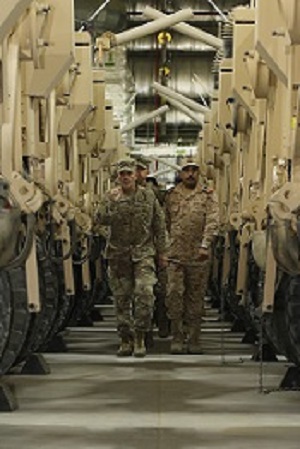
Maj. Gen. Ali A. Al-Shanfa, Chief of Staff Logistics and Supply for the Kuwait Army, gets a tour of a warehouse full of Mine-Resistant Ambush Protective Vehicles led by Maj. Gen. Flem B. "Donnie" Walker Jr., Commanding General of the 1st Theater Sustainment Command during the Bilateral Conference between Kuwait and 1st TSC on Nov. 26. The conference was designed to develop collaborative dialogue with Kuwaiti partners that enables them to create a shared understanding of future objectives for the Trans-Arabian Network and other key partner nation capabilities. (U.S. Army photo by Sgt. 1st Class Lisa Rodriguez-Presley)
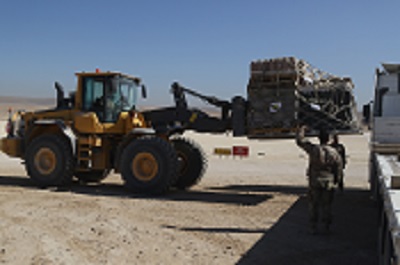
NORTHERN Syria – As supplies come into Syria, members of the 1st Theater Sustainment Command’s Forward Logistics Element load, sort and move them across the country, ensuring they reach their needed locations. (U. S. Army photo by Staff Sgt. Charlotte Reavis, 143d Sustainment Command (Expeditionary)
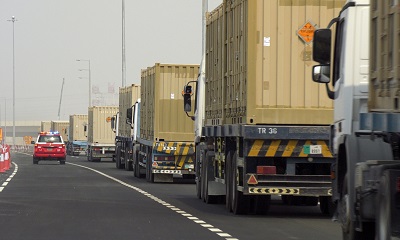
A convoy of vehicles heads to the Port of Masaieed, Qatar on Sept. 20 as part of the quarterly mission of the 831st Transportation Battalion. The 831st manages U.S. Army port operations in multiple countries throughout the area of responsibility, providing uninterrupted sustainment operations to warfighters in theater. (U.S. Army photo by Sgt. 1st Class Lisa Rodriguez-Presley)
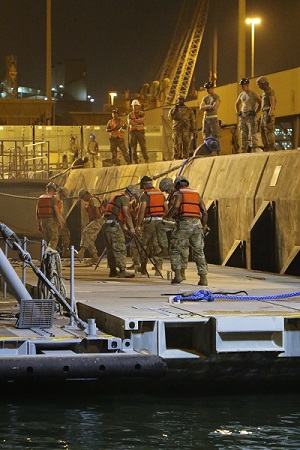
SHUIABA PORT, Kuwait – Soldiers assigned with the 331st Transportation Company, based out of Joint Base Langley-Eustis, Va., work with the 38th Sustainment Brigade to ensure the strings of International Organization for Standardization Package (ISOPAK) modules in the port are placed together correctly so they can build the Roll-on/Roll-off Discharge Facilities for the Logistics-over-the-Shore mission during Nautical Horizon 2018. Nautical Horizon 2018 is a two-stage U.S. Army Central (USARCENT)/ Coalition Forces Land Component Command (CFLCC) exercise that conducts an Army Watercraft Brigade Inspection Reconnaissance Exercise (BIREP) on Army Prepositioned Site (APS-5) vessels in conjunction with a LOTS exercise. (U.S. Army Photo by Staff Sgt. Charlotte Reavis/Released)
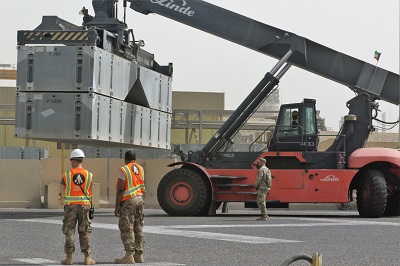
SHUAIBA PORT, Kuwait – Staff Sgt. Joshua Gross, watercraft operations sergeant, 331st Transportation Company, based out of Joint Base Langley- Eustis, Va., directs where he wants specific ISOPAK pieces of the Roll-on/Roll-off Discharge facility to be staged at the port. The RRDF builds are just one component of the Army’s first Nautical Horizon exercise, which officially kicked off on June 10. Nautical Horizon 2018 is a two-stage U.S. Army Central/ (USARCENT)/ Coalition Forces Land Component Command (CFLCC) exercise that conducts an Army Watercraft Brigade Inspection Reconnaissance Exercise (BIREP) on Army Prepositioned Site (APS-5) vessels in conjunction with a Logistics-over-the-shore (LOTS) exercise. (Photo by Staff Sgt. Charlotte Reavis, 143d Sustainment Command (Expeditionary))
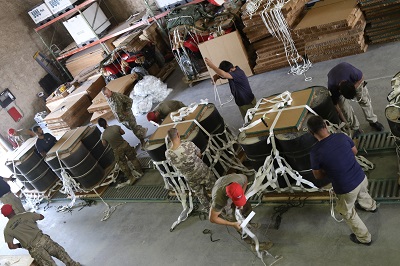
AL UDEID AIR BASE, Qatar – Members of the 824th Quartermaster Company, Detachment 11 work with the Qatar military on May 7 to advise and assist them with various rigging techniques. The Qatar military is working with the U.S. military to set up their C-17 air drop program so that the nation can be self-sustaining on supply drops. (U.S. Army Photo by Staff Sgt. Charlotte Reavis, 1st TSC-OCP Public Affairs)
